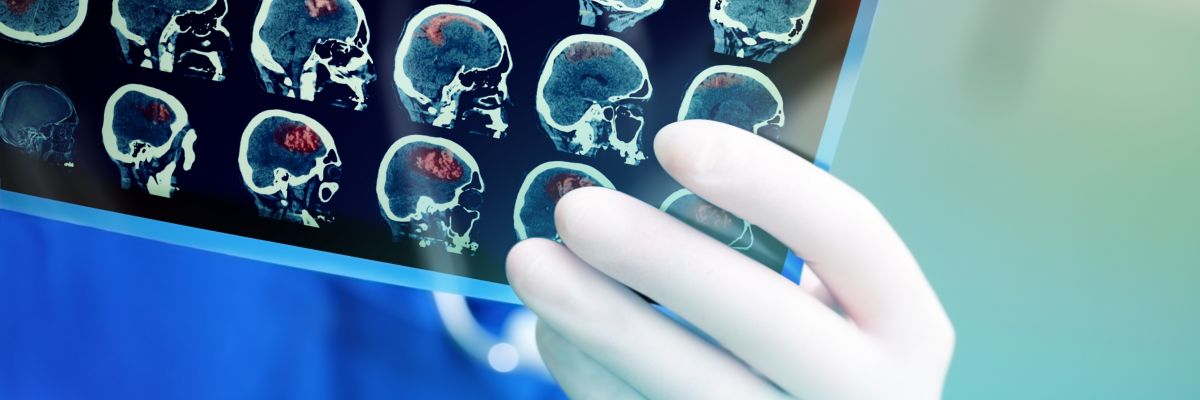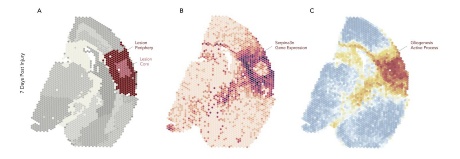
Groundbreaking study maps brain’s recovery process after stroke
21. 11. 2024
Every year, tens of thousands of people in the Czech Republic experience a stroke. A team of scientists from the Institute of Biotechnology of the CAS and the Institute of Experimental Medicine of the CAS, in cooperation with experts from the Institute for Clinical and Experimental Medicine (IKEM), has made significant strides in understanding how the brain recovers after a stroke. Their findings were published in Proceedings of the National Academy of Sciences (PNAS).
To create a detailed map of molecular and cellular changes in glial cells during the critical first week following an ischemic stroke in a pre-clinical mouse model, the researchers utilized advanced spatial transcriptomics. “Spatial transcriptomics allows us to see not just which genes are active, but precisely where they are active within the brain,” says Daniel Žucha, lead author of the study from the Institute of Biotechnology of the Czech Academy of Sciences (CAS), adding that “using a pre-clinical stroke model, this spatial context is crucial for understanding the complex interactions during stroke recovery and opens up exciting possibilities for deeper insights into the recovery process.”
The critical role of glial cells
By mapping gene expression patterns in their exact locations in the brain, researchers discovered how glial cells like astrocytes, microglia, and particularly oligodendrocytes enter activated states that vary depending on their proximity to the injury site.
“Understanding the spatial dynamics of glial cell activation helps us understand how the brain limits damage and promotes recovery,” says Miroslava Anděrová, a senior author from the Institute of Experimental Medicine of the CAS. A glial scar forms around the damaged tissue. As she explains further, this glial scar “is not just a barrier but a dynamic environment where crucial cell-to-cell communication occurs.”
The study also reveals how different cell types contribute to the formation of the glial scar, highlighting in particular the role of oligodendrocytes in modulating inflammation and supporting recovery. “Our findings highlight the active role of oligodendrocytes in this process, suggesting that they play a more involved role in recovery than previously thought,” notes Lukáš Valihrach, a senior author from the Institute of Biotechnology of the CAS. These recent findings provide a new perspective on the diverse functions of glial cells beyond passive support of neuronal cells.

Key components of the cellular response to stroke.
Supported by the Czech Science Foundation (GACR), the research not only deepens our understanding of stroke pathobiology, but also highlights the transformative potential of spatial transcriptomics in neuroscience research. The team plans to build on these findings with a new study using human ischemic samples, bringing this line of research closer to potential clinical applications for stroke recovery.
Written and prepared by: Markéta Wernerová, External Relations Division, CAO of the CAS
Translated by: Tereza Novická, External Relations Division, CAO of the CAS, drawing on the CAS press release
Photo: Shutterstock; Institute of Biotechnology of the CAS
 The text is released for use under the Creative Commons license.
The text is released for use under the Creative Commons license.
Read also
- ERC Consolidator Grant heads to the CAS for “wildlife on the move” project
- A little-known chapter of history: Czechoslovaks who fought in the Wehrmacht
- Twenty years of EURAXESS: Supporting researchers in motion
- Researching scent: Cleopatra’s legacy, Egyptian rituals, and ancient heritage
- The secret of termites: Long-lived social insects that live in advanced colonies
- Two ERC Synergy Grants awarded to the Czech Academy of Sciences
- Nine CAS researchers received the 2025 Praemium Academiae and Lumina Quaeruntur
- Step inside the world of research: Week of the Czech Academy of Sciences 2025
- A / Magazine: Bugs, the rusting human body, and beauties from the kingdom of ice
- PHOTO STORY: The invasive black bullhead catfish threatens Czech fishponds
The Czech Academy of Sciences (the CAS)
The mission of the CAS
The primary mission of the CAS is to conduct research in a broad spectrum of natural, technical and social sciences as well as humanities. This research aims to advance progress of scientific knowledge at the international level, considering, however, the specific needs of the Czech society and the national culture.
President of the CAS
Prof. Eva Zažímalová has started her second term of office in May 2021. She is a respected scientist, and a Professor of Plant Anatomy and Physiology.
She is also a part of GCSA of the EU.